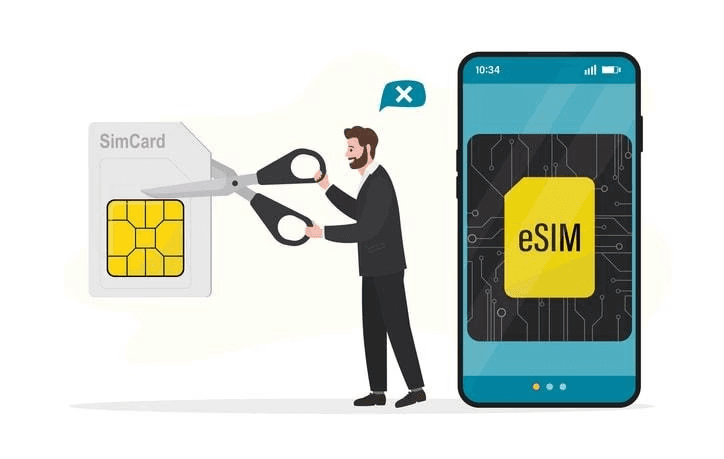How Do SIM Cards Work?
By
Liz Fujiwara
•
Oct 22, 2025
A SIM card is the key to connecting your phone to a mobile network. This small chip stores crucial data such as your phone number, carrier information, and authentication credentials, allowing your device to communicate with your mobile provider. It’s what enables you to make calls, send texts, and access mobile data seamlessly wherever you go.
Beyond basic connectivity, understanding how a SIM card works can help you manage your mobile settings more effectively, whether you’re troubleshooting signal issues, switching between devices, or upgrading to a new phone. This article explores what a SIM card does, the different types available, and how to keep your mobile information secure and accessible.
Key Takeaways
A SIM card, or Subscriber Identity Module, is essential for connecting mobile devices to carrier networks, storing user data and unique identifiers for authentication.
The evolution of SIM card sizes, from full-size to nano SIM, reflects advancements in mobile technology and the demand for more compact, efficient devices.
Embedded SIM (eSIM) technology allows users to manage mobile subscriptions remotely, offering greater flexibility and security while eliminating the need for physical SIM cards.
What is a SIM Card?

A SIM card, or Subscriber Identity Module, is a small plastic card embedded with a silicon chip that stores crucial user data. Its primary purpose is to connect users to carrier networks, enabling them to make calls, send texts, and access mobile data. By storing unique identifiers such as the International Mobile Subscriber Identity (IMSI) and the Integrated Circuit Card Identifier (ICCID), SIM cards authenticate users on mobile networks and facilitate secure communication through a universal integrated circuit card.
These versatile cards are essential for a variety of mobile devices, including smartphones, tablets, and smartwatches. SIM cards are highly portable, they can be easily removed from one device and inserted into another, allowing users to switch devices without losing mobile service. A mobile phone without a SIM card cannot access the cellular network, making it incapable of making calls or using mobile data.
SIM cards are the linchpins of modern mobile communication, providing the essential credentials that allow devices to connect to cellular networks and ensuring user information is securely stored and transferred between services, mobile providers, and network operators.
How Do SIM Cards Work?

A sophisticated process enables SIM cards to allow mobile devices to access cellular networks:
Each SIM card contains a unique identification number, the IMSI, which is crucial for authenticating the device with the carrier’s network. A mobile phone uses the IMSI stored on the SIM card to request authentication from the carrier when attempting to connect to a network. This process ensures that only authorized devices can access the network, providing security for both the user and the network operator.
The ICCID, another critical identifier on the SIM card, serves as a unique, non-duplicable ID reflecting details such as the industry, country, and service provider network. This identifier plays a pivotal role in differentiating each SIM card from others, ensuring that every card is uniquely recognized by the network.
Authentication is a multi-step process involving the Ki, a unique authentication key stored on the SIM card. The SIM card uses a GSM algorithm to sign data with the Ki, verifying the subscriber’s identity when a device connects to the network. This secure process ensures that the device is authorized to make calls, send texts, and use mobile data.
SIM cards also store a Location Area Identity (LAI), which helps the network determine the user’s current location. This information, along with the Mobile Country Code (MCC) and Mobile Network Code (MNC), allows the network to identify the user’s service provider and facilitate seamless connectivity.
Overall, SIM cards function by securely storing and transmitting critical identifiers and authentication keys, enabling mobile devices to connect to cellular networks smoothly and securely.
Evolution of SIM Card Sizes
The journey of SIM cards has seen significant changes in size and form factor, driven by the need for more compact mobile devices. From the full-size SIM card introduced in 1991, roughly the size of a credit card, to the tiny nano SIM cards used in modern smartphones, the evolution of SIM card sizes reflects advancements in mobile technology and the demand for sleeker, more efficient devices.
Full-Size SIM Card (1FF)
The full-size SIM card, introduced in 1991, was approximately the size of a standard credit card. With a memory capacity of 32 KB, it was primarily used in older cell phone models from the early to mid-1990s.
Advancements in mobile technology led to a decline in the use of full-size SIM cards as the need for smaller and more efficient versions increased.
Mini SIM Card (2FF)
In 1996, the mini SIM card was introduced, significantly reducing the size from approximately three inches to one inch in length. This smaller form factor quickly gained popularity and became the standard for mobile phones during the late 1990s and early 2000s. The mini SIM card offered a more compact and efficient solution, accommodating the increasing demand for smaller and more portable mobile devices.
The mini SIM card’s reduced size allowed for more design flexibility and space for additional components within evolving mobile phones. This innovation paved the way for further advancements in SIM card technology, leading to even smaller and more efficient formats.
Micro SIM Card (3FF)
The micro SIM card, introduced in 2003, marked another significant reduction in size, facilitating the design of more compact and efficient mobile devices. Its smaller dimensions allowed for better utilization of space within smartphones, accommodating additional components and enhancing overall device design.
Micro SIM cards quickly became standard in many smartphones due to their reduced size and improved design efficiency. This evolution underscored the ongoing trend toward miniaturization in mobile technology, paving the way for the even smaller nano SIM cards.
Nano SIM Card (4FF)
The nano SIM card, introduced in 2012, represents the smallest SIM card format available, classified as 4FF. This tiny card further optimized space within modern smartphones, allowing for even more compact and efficient device designs. Most modern iOS and Android devices, including models from the iPhone 5 to the iPhone 13, are compatible with nano SIM cards, reflecting their widespread adoption in the industry.
The nano SIM card exemplifies the continuous drive for innovation and efficiency in mobile device technology, ensuring devices remain sleek and powerful while maintaining essential connectivity features for users.
Embedded SIM (eSIM) Technology

Embedded SIM (eSIM) technology represents a significant leap forward in mobile connectivity. An eSIM is a programmable SIM embedded directly into a device, eliminating the need for a physical SIM card. This innovation allows users to manage their mobile network subscriptions remotely, providing greater flexibility and convenience.
A major benefit of eSIM technology is the ability to switch carriers without physically changing the SIM card, which is especially advantageous for international travel. Users can activate a new service plan from a local carrier without the hassle of purchasing and inserting a new physical SIM card. This remote provisioning capability improves the overall user experience and simplifies the process of managing multiple carrier subscription profiles.
eSIM technology is poised to revolutionize the mobile industry, with expectations for enhanced security measures and broader integration into devices beyond smartphones, such as laptops and IoT gadgets, as defined by the European Telecommunications Standards Institute. The convenience, flexibility, and potential cost savings offered by eSIMs make them a promising development in the ever-evolving landscape of mobile connectivity.
How to Choose the Right SIM Card for Your Device

Selecting the right SIM card for your device ensures optimal performance and connectivity. Different device requirements necessitate specific SIM sizes, such as:
Nano
Micro
Mini
Using the wrong size can lead to connectivity issues or slower speeds. For instance:
4G LTE devices can generally use most data plans.
5G devices require a compatible 5G data plan for optimal performance.
It’s also important to consider compatibility with your data plan and device model. Testing the SIM card with new hardware before committing helps avoid potential connectivity problems. Considering these factors ensures your device remains connected and performs at its best.
The Future of SIM Cards

The future of SIM cards promises to be as dynamic and transformative as their past. SIM cards will continue to play a vital role in mobile communications, with dual SIM options and virtual SIM technologies offering even greater flexibility and convenience. Dual SIM configurations now include combinations such as two physical SIMs, a physical SIM and an eSIM, or even two eSIMs, providing users with multiple ways to stay connected.
As devices become more advanced and offer greater storage and cloud capabilities, the need for high-capacity SIM cards may decrease. Instead, the focus is shifting toward integrated SIMs (iSIMs) and virtual SIMs, which could significantly transform connectivity by embedding SIM functionality directly into a device’s hardware. This evolution promises to enhance user experiences, reduce operational costs for carriers, and open new possibilities for device design and functionality.
The future of SIM technology looks bright, with ongoing innovations aimed at making mobile connectivity more seamless, efficient, and user-friendly. As we move toward a more connected world, SIM cards will continue to evolve, adapting to new technologies and user needs.
How Fonzi Can Help with Technical Hiring
Fonzi is revolutionizing the hiring landscape by connecting companies with top-tier AI talent through its curated AI engineering talent marketplace. Key features include:
Utilizing a structured hiring process to ensure candidates are matched with suitable roles, making the hiring process more efficient and effective.
Hosting Match Day events where candidates can receive multiple job offers within a 48-hour hiring window.
Streamlining the job search process and providing quicker results for both candidates and employers.
Candidates are pre-vetted to ensure they possess relevant skills and real-world experience, providing companies with high-quality talent. This approach benefits candidates and helps companies find the best fit for their roles, increasing overall productivity and satisfaction.
Fonzi’s cost-effective model, where companies only pay a success fee upon successfully hiring a candidate, makes it an attractive option for employers. By delivering high-signal, structured evaluations and supporting both early-stage startups and large enterprises, Fonzi makes hiring fast, consistent, and scalable, helping companies find the right talent in a timely manner.
Summary
In summary, SIM cards have evolved significantly from their full-size origins to the compact nano SIMs used in today’s devices. They play a crucial role in mobile connectivity, storing essential data and authenticating devices on cellular networks. The advent of eSIM technology promises even greater flexibility and convenience, allowing users to manage mobile subscriptions remotely and switch carriers with ease.
Looking ahead, the future of SIM technology is bright, with innovations such as virtual SIMs and iSIMs poised to transform mobile connectivity. As we continue advancing toward a more connected world, the role of SIM cards will evolve, adapting to new technologies and user needs.




